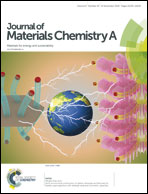Extending cycling life of lithium–oxygen batteries based on novel catalytic nanofiber membrane and controllable screen-printed method†
Abstract
The surface and interface configuration of catalysts has been considered as a useful strategy to achieve high oxygen reduction and oxygen evolution reaction activities for Li–O2 batteries. Herein, the facile synchronous reduction method and screen-printing process are applied to obtain an Ru–rGO catalyst with a 3D porous architecture and oxygen electrodes. Significantly, an ultra-long cycling Li–O2 cell is designed using catalytic membrane decoration. The catalytic membrane is fabricated via electrospinning polyacrylonitrile (PAN) nanofibers directly onto a separator. Then, Ag nanowires and Au nanoparticles are coated on previously obtained PAN scaffolds. After comparing initial Ru–rGO electrode with decorated Ru–rGO (D-Ru-rGO), we infer that the cell with D-Ru-rGO catalyst exhibits enhanced cycling performance towards ORR and OER, higher specific discharge capacity (13 437.8 mA h g−1), extended cycling stability, desirable rate performance, and a lower voltage gap. The insulating PAN polymer framework can directly restrict electron transfer to the Ag/Au catalyst and effectively prevent Ag/Au catalytic sites from direct blockage. Thus, the efficient and effective method proposed in this study offers a new insight into architecture designing and synergetic surface/interface strategy settling.



 Please wait while we load your content...
Please wait while we load your content...